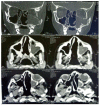Embryonal rhabdomyosarcoma in the maxillary sinus with orbital involvement in a pediatric patient: Case report
- PMID: 29291204
- PMCID: PMC5740190
- DOI: 10.12998/wjcc.v5.i12.440
Embryonal rhabdomyosarcoma in the maxillary sinus with orbital involvement in a pediatric patient: Case report
Abstract
This report presents a case of embryonal rhabdomyosarcoma (eRMS) located in the left maxillary sinus and invading the orbital cavity in a ten-year-old male patient who was treated at a referral hospital. The images provided from the computed tomography showed a heterogeneous mass with soft-tissue density, occupying part of the left half of the face inside the maxillary sinus, and infiltrating and destroying the bone structure of the maxillary sinus, left orbit, ethmoidal cells, nasal cavity, and sphenoid sinus. An analysis of the histological sections revealed an undifferentiated malignant neoplasm infiltrating the skeletal muscle tissue. The immunohistochemical analysis was positive for the antigens: MyoD1, myogenin, desmin, and Ki67 (100% positivity in neoplastic cells), allowing the identification of the tumour as an eRMS. The treatment protocol included initial chemotherapy followed by radiotherapy and finally surgery. The total time of the treatment was nine months, and in 18-mo of follow-up period did not show no local recurrences and a lack of visual impairment.
Keywords: Chemotherapy; Embryonal rhabdomyosarcoma; Maxillary sinus; Oncology; Pediatrics.
Conflict of interest statement
Conflict-of-interest statement: We, the authors of this paper “Embryonal rhabdomyosarcoma in the maxillary sinus with orbital involvement in a pediatric patient: Case report”, stating that we participate sufficiently in the design of the study and development of this work and we take public responsibility on it and we delegate to the World Journal of Clinical Cases the copyright upon acceptance of the publication of this. The authors undersigned declare no conflict of interest regarding this manuscript, as well as the information it contains.
Figures





Similar articles
-
Diagnosis and Treatment of Rare Adult Embryonal Rhabdomyosarcoma in Maxillary Sinus.J Craniofac Surg. 2023 Jul-Aug 01;34(5):e505-e507. doi: 10.1097/SCS.0000000000009378. Epub 2023 May 25. J Craniofac Surg. 2023. PMID: 37226309
-
Myogenin and desmin immunohistochemistry in the assessment of post-chemotherapy genitourinary embryonal rhabdomyosarcoma: prognostic and management implications.J Urol. 2006 Oct;176(4 Pt 2):1751-4. doi: 10.1016/j.juro.2006.03.117. J Urol. 2006. PMID: 16945640
-
Anlotinib treatment for rapidly progressing pediatric embryonal rhabdomyosarcoma in the maxillary gingiva: a case report.Diagn Pathol. 2024 Oct 8;19(1):135. doi: 10.1186/s13000-024-01555-5. Diagn Pathol. 2024. PMID: 39379998 Free PMC article.
-
Rhabdomyosarcoma of the maxillary gingiva.J Periodontol. 2007 Sep;78(9):1839-45. doi: 10.1902/jop.2007.060454. J Periodontol. 2007. PMID: 17760557 Review.
-
[Pleomorphic adenoma of the nasal cavity: a case arising from the wall of the maxillary sinus].Rev Laryngol Otol Rhinol (Bord). 2002;123(2):103-7. Rev Laryngol Otol Rhinol (Bord). 2002. PMID: 12360715 Review. French.
Cited by
-
Pediatric Sinonasal Rhabdomyosarcoma Presented as Squint: A Case Report and Literature Review.Cureus. 2021 Oct 6;13(10):e18548. doi: 10.7759/cureus.18548. eCollection 2021 Oct. Cureus. 2021. PMID: 34754692 Free PMC article.
-
Orbital Rhabdomyosarcoma Masquerading as a Dermoid Cyst: A Case Report and Review of the Literature.Cureus. 2023 Dec 11;15(12):e50332. doi: 10.7759/cureus.50332. eCollection 2023 Dec. Cureus. 2023. PMID: 38205487 Free PMC article.
-
Expanding the Spectrum of Intraosseous Rhabdomyosarcoma: Correlation Between 2 Distinct Gene Fusions and Phenotype.Am J Surg Pathol. 2019 May;43(5):695-702. doi: 10.1097/PAS.0000000000001227. Am J Surg Pathol. 2019. PMID: 30720533 Free PMC article.
References
-
- Reilly BK, Kim A, Peña MT, Dong TA, Rossi C, Murnick JG, Choi SS. Rhabdomyosarcoma of the head and neck in children: review and update. Int J Pediatr Otorhinolaryngol. 2015;79:1477–1483. - PubMed
-
- Garay M, Chernicoff M, Moreno S, Pizzi de Parra N, Oliv, J, Apréa G. Rabdomiosarcoma alveolare congenito in un neonato. Eur J Pediatr Dermatol. 2004;14:9–12.
Publication types
LinkOut - more resources
Full Text Sources
Other Literature Sources

